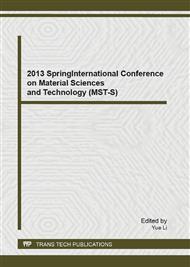[1]
Niu XP, Hu BH, Pinwill I, Li H. Vacuum assisted high pressure die casting of aluminium alloys. J Mater Process Technol. 2000;105:119-27.
DOI: 10.1016/s0924-0136(00)00545-8
Google Scholar
[2]
Brungs D. Light weight design with light metal castings. Mater Design. 1997;18:285-91.
DOI: 10.1016/s0261-3069(97)00065-4
Google Scholar
[3]
Carle D, Blount G. The suitability of aluminium as an alternative material for car bodies. Mater Design. 1999;20:267-72.
DOI: 10.1016/s0261-3069(99)00003-5
Google Scholar
[4]
Kaufmann H, Uggowitzer PJ. Metallurgy and Processing of High-Integrity Light Metal Pressure Castings: Schiele & Schön; 2007.
Google Scholar
[5]
With M, Koch H, Klos R. Experiences from the mass production of die cast steering wheel frames from the alloy AlMg5Si2Mn. Giesserei (Germany). 1999;86:185-9.
Google Scholar
[6]
ASTM Standard B85: Standard Specification for Aluminum-Alloy Die Castings. Annual book of ASTM Standards, vol.02.02 ed. USA: ASTM International; 2010.
Google Scholar
[7]
Greven K, Dragulin D. Ductile High Pressure Die Casting - Heat Treated or Temper F? the 2nd International Conference on Light Metals Technology2005. pp.221-6.
Google Scholar
[8]
Koch H, Hielscher U, Sternau H, Franke A. Magsimal-59-an AlMgMnSi type squeeze casting alloy designed for temper F Light Metals 1996:933-7.
Google Scholar
[9]
Kaufmann H, Uggowitzer PJ. Fundamentals of the New Rheocasting Process for Magnesium Alloys. Adv Eng Mater. 2001;3:963-7.
DOI: 10.1002/1527-2648(200112)3:12<963::aid-adem963>3.0.co;2-x
Google Scholar
[10]
Grimmig T, Ovcharov A, Afrath C, Bunck M, Buhrig-Polaczek A. Potential of the rheocasting process, demonstrated on different aluminum based alloy systems. In: Kang CG, Kim SK, Lee SY, editors. Semi- Solid Processing of Alloys and Composites. Stafa-Zurich: Trans Tech Publications Ltd; 2006. pp.484-8.
Google Scholar
[11]
Hu Z, Wan L, Wu S, Wu H, Liu X. Microstructure and mechanical properties of high strength die-casting Al–Mg–Si–Mn alloy. Mater Design. 2013;46:451-6.
DOI: 10.1016/j.matdes.2012.10.020
Google Scholar
[12]
Franke R, Dragulin D, Zovi A, Casarotto F. Progress in ductile aluminum high pressure die casting alloys for the automotive industry. la metallurgia italiana. 2007.
Google Scholar
[13]
Otarawanna S, Gourlay CM, Laukli HI, Dahle AK. Formation of the surface layer in hypoeutectic Al-alloy high-pressure die castings. Mater Chem Phys. 2011.
DOI: 10.1016/j.matchemphys.2011.06.035
Google Scholar
[14]
Otarawanna S, Laukli HI, Gourlay CM, Dahle AK. Feeding Mechanisms in High-Pressure Die Castings. Metall. Mater. Trans A. 2010;41:1836-46.
DOI: 10.1007/s11661-010-0222-6
Google Scholar
[15]
Ji S, Watson D, Fan Z, White M. Development of a super ductile diecast Al–Mg–Si alloy. Mater Sci Eng A. 2012;556:824-33.
DOI: 10.1016/j.msea.2012.07.074
Google Scholar


